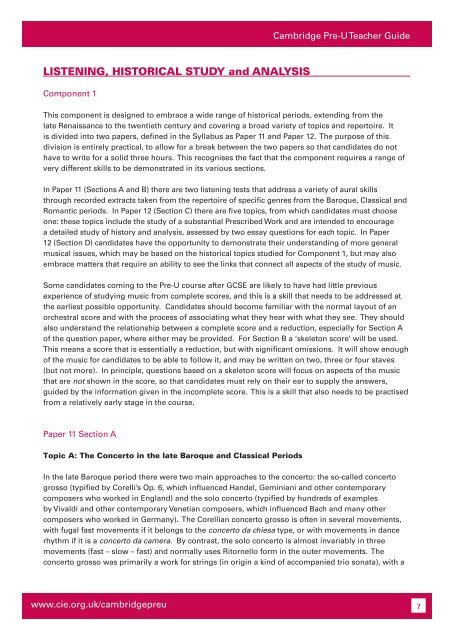Teacher's Guide Cambridge Pre-U MUSIC Available for teaching ...
Teacher's Guide Cambridge Pre-U MUSIC Available for teaching ...
Teacher's Guide Cambridge Pre-U MUSIC Available for teaching ...
Create successful ePaper yourself
Turn your PDF publications into a flip-book with our unique Google optimized e-Paper software.
LISTENING, HISTORICAL STUDY and ANALYSIS<br />
Component 1<br />
<strong>Cambridge</strong> <strong>Pre</strong>-U Teacher <strong>Guide</strong><br />
This component is designed to embrace a wide range of historical periods, extending from the<br />
late Renaissance to the twentieth century and covering a broad variety of topics and repertoire. It<br />
is divided into two papers, defined in the Syllabus as Paper 11 and Paper 12. The purpose of this<br />
division is entirely practical, to allow <strong>for</strong> a break between the two papers so that candidates do not<br />
have to write <strong>for</strong> a solid three hours. This recognises the fact that the component requires a range of<br />
very different skills to be demonstrated in its various sections.<br />
In Paper 11 (Sections A and B) there are two listening tests that address a variety of aural skills<br />
through recorded extracts taken from the repertoire of specific genres from the Baroque, Classical and<br />
Romantic periods. In Paper 12 (Section C) there are five topics, from which candidates must choose<br />
one: these topics include the study of a substantial <strong>Pre</strong>scribed Work and are intended to encourage<br />
a detailed study of history and analysis, assessed by two essay questions <strong>for</strong> each topic. In Paper<br />
12 (Section D) candidates have the opportunity to demonstrate their understanding of more general<br />
musical issues, which may be based on the historical topics studied <strong>for</strong> Component 1, but may also<br />
embrace matters that require an ability to see the links that connect all aspects of the study of music.<br />
Some candidates coming to the <strong>Pre</strong>-U course after GCSE are likely to have had little previous<br />
experience of studying music from complete scores, and this is a skill that needs to be addressed at<br />
the earliest possible opportunity. Candidates should become familiar with the normal layout of an<br />
orchestral score and with the process of associating what they hear with what they see. They should<br />
also understand the relationship between a complete score and a reduction, especially <strong>for</strong> Section A<br />
of the question paper, where either may be provided. For Section B a ‘skeleton score’ will be used.<br />
This means a score that is essentially a reduction, but with significant omissions. It will show enough<br />
of the music <strong>for</strong> candidates to be able to follow it, and may be written on two, three or four staves<br />
(but not more). In principle, questions based on a skeleton score will focus on aspects of the music<br />
that are not shown in the score, so that candidates must rely on their ear to supply the answers,<br />
guided by the in<strong>for</strong>mation given in the incomplete score. This is a skill that also needs to be practised<br />
from a relatively early stage in the course.<br />
Paper 11 Section A<br />
Topic A: The Concerto in the late Baroque and Classical Periods<br />
In the late Baroque period there were two main approaches to the concerto: the so-called concerto<br />
grosso (typified by Corelli’s Op. 6, which influenced Handel, Geminiani and other contemporary<br />
composers who worked in England) and the solo concerto (typified by hundreds of examples<br />
by Vivaldi and other contemporary Venetian composers, which influenced Bach and many other<br />
composers who worked in Germany). The Corellian concerto grosso is often in several movements,<br />
with fugal fast movements if it belongs to the concerto da chiesa type, or with movements in dance<br />
rhythm if it is a concerto da camera. By contrast, the solo concerto is almost invariably in three<br />
movements (fast – slow – fast) and normally uses Ritornello <strong>for</strong>m in the outer movements. The<br />
concerto grosso was primarily a work <strong>for</strong> strings (in origin a kind of accompanied trio sonata), with a<br />
www.cie.org.uk/cambridgepreu 7
















